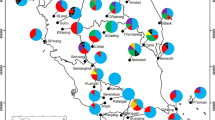Abstract
Ecological factors affecting reproduction and dispersal are particularly important in determining genetic structure of plant populations. Polyoicous reproductive system is not rare in bryophytes; however, to date, nothing is known about its functioning and possible population genetic effects. Using the liverwort Mannia fragrans as a model species, the main aims of this study were to separate the relative importance of the components of the polyoicous reproductive system and to assess its consequences on the genetic structure of populations. High sex expression rates increasing with patch size and strongly female-biased sex ratios were detected. Additional input into clonal growth after production of sex organs was found in males compared to females. Similar clonal traits of the rare bisexual and asexual plants and preference toward newly colonized patches suggest that selection prefers colonizers that first develop organs of both sexes, hence ensuring sexual reproduction when no partner is present. Despite frequent spore production, ISSR markers revealed low genetic diversity, probably resulting from the effective clonal propagation of the species and frequent crossing between genetically identical plants. The presence of numerous rare alleles and unique recombinant haplotypes indicates occasional recombination and mutation. Effective spreading of new haplotypes is probably hampered however by large spore size. Since populations are small and isolated, such haplotypes are probably continuously eliminated by genetic drift. These results suggest that although both sexual and asexual reproductions seem to be effective, asexual components of the reproductive system play a greater role in shaping the genetic composition of the populations.


Similar content being viewed by others
References
Agapow PM, Burt A (2000) MultiLocus 1.2. Analysing multi-locus population genetic data. Department of Biology, Imperial College, Ascot
Bhatla SC, Chopra RN (1981) Hormonal regulation of gametangial formation in the moss Bryum argenteum Hedw. J Exp Bot 32:1243–1256
Bisang I, Ehrlén J (2002) Reproductive effort and cost of sexual reproduction in female Dicranum polysetum. Bryologist 105:384–397. doi:10.1639/0007-2745(2002)105[0384:REACOS]2.0.CO;2
Bisang I, Hedenäs L (2005) Sex ratio patterns in dioicous bryophytes re-visited. J Bryol 7:207–219. doi:10.1179/174328205X69959
Bischler H, Boisselier-Dubayle MC (1993) Variation in a polyploid, dioicous liverwort, Marchantia globosa. Am J Bot 80:953–958. doi:10.2307/2445516
Boisselier-Dubayle MC, Bischler H (1997) Enzyme polymorphism in Preissia quadrata (Hepaticae, Marchantiaceae). Plant Syst Evol 205:73–84. doi:10.1007/BF00982798
Chopra RN, Sood S (1973) In vitro studies in Marchantiales. I. Effects of some carbohydrates, agar, pH, light and growth regulators on the growth and sexuality in Riccia crystallina. Phytomorphology 23:230–244
Damsholt K (2002) Illustrated flora of nordic liverworts and hornworts. Nordic Bryological Society, Lund
Dewey RM (1989) Genetic variation in the liverwort Riccia dictyospora (Ricciaceae, Hepaticopsida). Syst Bot 14:155–167. doi:10.2307/2418903
During HJ (1992) Ecological classification of bryophytes and lichens. In: Bates JW, Farmer AM (eds) Bryophytes and lichens in a changing environment. Oxford University Press, Oxford
Excoffier L, Laval G, Schneider S (2005) Arlequin (version 3.0): an integrated software package for population genetics data analysis. Evol Bioinform Online 1:47–50
Fernandez H, Bertrand AM, Feito I, Sanchez-Tames R (1997) Gametophyte culture in vitro and atheridiogen activity in Blechnum spicant. Plant Cell Tissue Organ Cult 50:71–74. doi:10.1023/A:1005962726905
Fisher RA (1930) The genetic theory of natural selection. Oxford University Press
Fritsch R (1991) Index to bryophyte chromosome counts. Bryophytorum Bibl 40, J. Cramer, Berlin-Stuttgart
Glime JM (2007) Bryophyte ecology, vol 1. Physiological ecology. Ebook sponsored by Michigan Technological University and the International Association of Bryologists. http://www.bryoecol.mtu.edu. Accessed 24 Nov 2008
Gunnarsson U, Hassel K, Söderström L (2005) Genetic structure of the endangered peat moss Sphagnum angermanicum in Sweden: a result of historic or contemporary processes? Bryologist 108:194–203. doi:10.1639/0007-2745(2005)108[0194:GSOTEP]2.0.CO;2
Hassel K, Såstad SM, Gunnarsson U et al (2005) Genetic variation and structure in the expanding moss Pogonatum dentatum (Polytrichaceae) in its area of origin and in a recently colonized area. Am J Bot 92:1684–1690. doi:10.3732/ajb.92.10.1684
Haupt AW (1921) Gametophyte and sex organs of Reboulia hemisphaerica. Bot Gaz 71:61–74. doi:10.1086/332789
Haupt AW (1926) Morphology of Preissia quadrata. Bot Gaz 82:30–54. doi:10.1086/333632
Haupt AW (1929) Studies in Californian Hepaticae. I. Asterella californica. Bot Gaz 87:302–319. doi:10.1086/333935
Hock Z (2007) Propagule banks in bryophytes and ferns: dynamics, genetic composition and the role of the life history. PhD thesis, University of Zurich, Switzerland
Hock Zs, Szövényi P, Schneller JJ, Urmi E, Tóth Z (2008) Are sexual or asexual events determining the genetic structure of populations in the liverwort Mannia fragrans? J Bryol 30:66–73
Kimmerer RW (1994) Ecological consequences of sexual versus asexual reproduction in Dicranum flagellare and Tetraphis pellucida. Bryologist 97:20–25. doi:10.2307/3243344
Khanna KR (1964) Differential evolutionary activity in bryophytes. Evolution 18:652–670. doi:10.2307/2406218
Korpelainen H (1998) Labile sex expression in plants. Biol Rev Camb Philos Soc 73:157–180. doi:10.1017/S0006323197005148
Kumra PK, Chopra RN (1983) Effect of some physical factors on growth and gametangial induction in male clones of three mosses grown in vitro. Bot Gaz 144:533–539. doi:10.1086/337407
Leitgeb H (1881) Untersuchungen über die Lebermoose, 6th edn. Die Marchantieen, Graz
Loveless MD, Hamrick JL (1984) Ecological determinants of genetic structure in plant populations. Annu Rev Ecol Syst 15:65–95. doi:10.1146/annurev.es.15.110184.000433
McLetchie DN, Puterbaugh MN (2000) Population sex ratios, sex-specific clonal traits and tradeoffs among these traits in the liverwort Marchantia inflexa. Oikos 90:227–237. doi:10.1034/j.1600-0706.2000.900203.x
Nei M (1987) Molecular evolutionary genetics. Columbia University Press
Odrzykoski I, Szweykowski J (1981) An interesting enzymatic polymorphism in some European populations of the liverwort Mannia fragrans (Balbis) Frye and Clark. In: Szweykowski J (ed) New perspectives in bryotaxonomy and bryogeography. Adam Mickiewicz University, Poznan
Paton JA (1999) The liverwort flora of the British Isles. Harley Books, Colchester
Peakall R, Smouse PE (2006) GENALEX 6: genetic analysis in Excel. Population genetic software for teaching and research. Mol Ecol Notes 6:288–295. doi:10.1111/j.1471-8286.2005.01155.x
Pohjamo M, Laaka-Lindberg S (2003) Reproductive modes in the epixylic hepatic Anastrophyllum hellerianum. Perspect Plant Ecol Evol Syst 6:159–168. doi:10.1078/1433-8319-00074
Ramsay HP, Berrie GK (1982) Sex determination in bryophytes. J Hattori Bot Lab 52:255–274
Read DJ, Duckett JG, Francis R et al (2000) Symbiotic fungal associations in ‘lower’ land plants. Philos Trans R Soc B Biol Sci 355:815–831. doi:10.1098/rstb.2000.0617
Rydgren K, Økland RH (2003) Short-term costs of sexual reproduction in the clonal moss Hylocomium splendens. Bryologist 106:212–220. doi:10.1639/0007-2745(2003)106[0212:SCOSRI]2.0.CO;2
Schuster RM (1992) The Hepaticae and Anthocerotae of North America east of the hundredth meridian, vol VI. Field Museum of Natural History, Chicago
Sokal RR, Rohlf FJ (1995) Biometry, 3rd edn. WH Freeman and Co, New York
SPSS for Windows, Release 11.0.1 (2001) SPSS Incorporated, Chicago, USA
Stark LR (2002a) Skipped reproductive cycles and extensive sporophyte abortion in the desert moss Tortula inermis correspond to unusual rainfall patterns. Can J Bot 80:533–542
Stark LR (2002b) Phenology and its repercussions on the reproductive ecology of mosses. Bryologist 105:204–218
Stark LR, McLetchie DN, Mishler BD (2001) Sex expression and sex dimorphism in sporophytic populations of the desert moss Syntrichia caninervis. Plant Ecol 157:183–196
Stearns SC (1989) Trade-offs in life-history evolution. Funct Ecol 3:259–268
Stenøien HK, Såstad SM (2001) Genetic variability in bryophytes: does mating system really matter? J Bryol 23:313–318
Szweykowski J, Zielinski R (1983) Isoenzymatic variation in polish populations of the moss Plagiothecium undulatum (Hedw.) B. S. G. A preliminary report. J Hattori Bot Lab 54:119–123
Wilkinson M (2001) PICA 4.0: software and documentation. Department of Zoology, The Natural History Museum, London
Wolfe AD, Liston A (1998) Contributions of the polymerase chain reaction to plant systematics. In: Soltis DE, Soltis PE, Doyle JJ (eds) Molecular systematics of plants II: DNA sequencing. Kluwer, New York
Wyatt R (1994) Population genetics of bryophytes in relation to their reproductive biology. J Hatt Bot Lab 76:147–157
Wyatt R, Anderson LE (1984) Breeding systems of bryophytes. In: Dyer AF, Duckett JG (eds) The experimental biology of bryophytes. Academic Press, London
Wyatt R, Stoneburner A, Odrzykoski I (1989) Bryophyte isozymes: systematic and evolutionary implications. In: Soltis DE, Soltis PS (eds) Plant isozymes. Dioscorides, Portland
Acknowledgements
This research was financially supported by a grant of the Hungarian Scientific Research Fund (OTKA-T047156).
Author information
Authors and Affiliations
Corresponding author
Rights and permissions
About this article
Cite this article
Hock, Z., Szövényi, P., Schneller, J.J. et al. Population genetic consequences of the reproductive system in the liverwort Mannia fragrans . Plant Ecol 202, 123–134 (2009). https://doi.org/10.1007/s11258-008-9541-8
Received:
Accepted:
Published:
Issue Date:
DOI: https://doi.org/10.1007/s11258-008-9541-8




